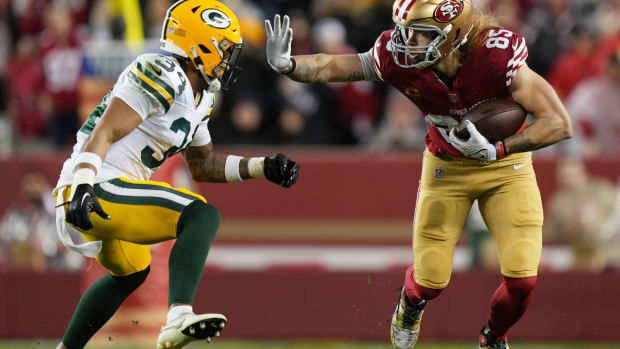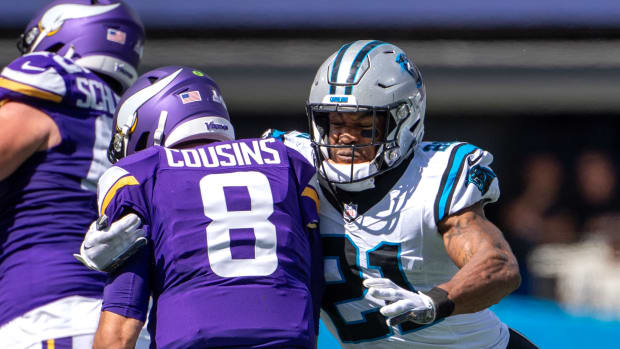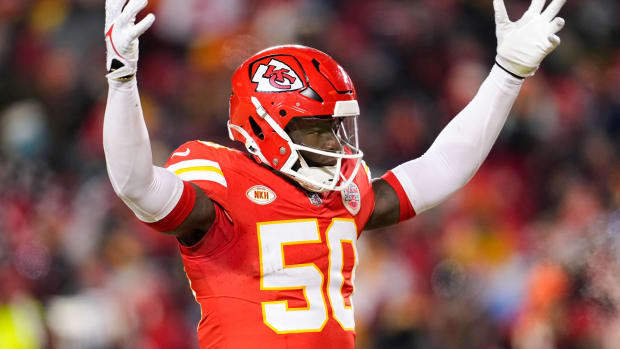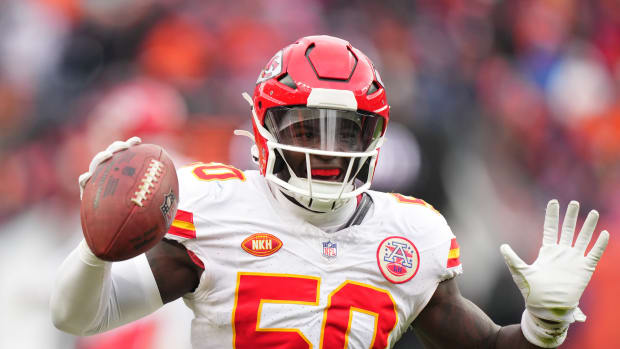There’s Another Mess in D.C.
The first day of the 2017 league year started with news on the fortunes of big-name players breaking left and right.
It ended with the ouster of one of the best in the business when it comes to picking those guys.
That the Redskins would part ways with general manager Scot McCloughan became inevitable as one day rolled into the next without him at last week’s scouting combine. The company line was that a death in his family (his grandmother passed away Feb. 6) was keeping him away. The rumors of his past battles with alcohol resurfacing were more sinister.
The truth? Well, the truth is that at least a part of this is the Redskins reverting once more to being the dysfunctional organization we’ve all gotten to know over the past decade-and-a-half.

Two key figures of the Redskins’ recent success—wide receiver Pierre Garcon and GM Scot McCloughan—are no longer in Washington.
Jonathan Newton / The Washington Post via Getty Images
And so here we at the start of the league year, when so many teams are celebrating new beginnings, with one of the NFL’s flagship franchises blowing things up yet again. Only this time it’s not at the beginning of January or even late in the season, when these things are happening all over the place. This time the Redskins are losing their top talent evaluator smack in the heart of talent-evaluation season.
Power struggles are nothing new in D.C., nor is the concept of disagreement metastasizing into disaster. It happened when Vinny Cerrato was the GM working with Jim Zorn. It happened when the Robert Griffin III era was initially derailed by a knee injury, then sent into a ditch by his uneven play. It was obvious when the tension between ex-coach Mike Shanahan and owner Dan Snyder came to a head.
Before that, there was the circus of Steve Spurrier’s two years. Before that, there was Marty Schottenheimer’s one-year stop-in between longer tenures in Kansas City and San Diego.
So this one went wrong the way things usually do in Washington. It started with arguments over roles and duties within the organization—and that led to power plays over decisions. One involved whether or not to use the franchise tag on quarterback Kirk Cousins. Another centered on allocating resources to fix the defense over the course of the 2017 offseason.
And there came a point where team president Bruce Allen took over. The reasoning will be the subject of debate, but that shift in power is ultimately, as I understand it, a major reason why McCloughan wound up sitting out the combine, which is as central to his job as any event on the NFL calendar. This time it wasn’t about ownership. It became McCloughan vs. Allen.
While McCloughan hasn’t been involved in any Redskins decision over the past two weeks, the team has followed his board early in free agency—safety DJ Swearinger and defensive tackles Terrell McClain and Stacy McGee were high on his list as he emphasized rebuilding the defense up the middle. Washington landed all three of those guys. And the draft board, while subject to change, also was set before he left.
Was there one thing that might have been done differently had all of this not happened? My sense is the Redskins may have made a stronger effort to keep Pierre Garçon, although even that is questionable based on how the Niners valued him.
What McCloughan’s rivals will tell you is that he leaves behind a roster that’s much more competitive at the bottom, stronger in the middle class, and sturdier overall than perhaps any during Snyder’s ownership of the team.
But all the optimism and goodwill, and the public trust that was restored over the past two years—the first consecutive winning seasons since Snyder bought the team—has vanished overnight. Now, the future of the franchise looks as murky as it did in that chaotic final season of Zorn.
Maybe Allen and Jay Gruden—who has proven to be a very good head coach—can steady the ship over the coming months. Maybe they can weather coordinator changes on each side of the ball, navigate a stormy situation with Kirk Cousins and manage the attrition at the skill positions.
All I know is that as strange as the last week in Washington may seem on the surface, a closer looks at the actual issues shows many of them to be awfully familiar.
* * *

The Patriots’ pending acquisition of cornerback Stephen Gilmore could lead to the team making another move soon.
Maddie Meyer/Getty Images
And with that, here are five thoughts to wrap up the first day of the league year …
• Good day to be an offensive linemen. New Rams tackle Andrew Whitworth, new Panthers tackle Matt Kalil and Browns guards Joel Bitonio and Kevin Zeitler all cracked eight figures in average per year, and new Broncos guard Ron Leary and new Lions tackle Ricky Wagner came close. Why? A really bad draft class at the position coupled with crying needs there across the league drove the market, and tied a lot of GMs’ hands.
• The Texans are in prime position to acquire Tony Romo.I still believe Romo would like to go to Houston, and I believe the Texans view Romo as a fit. What’s more, the Brock Osweiler trade clears $10 million in cap space. Romo is due just $14 million—well below average for a starting quarterback—in 2017. It’s all doable. Will the Texans risk waiting for the Cowboys to cut Romo? It might be smart to act now.
• Receiver cash is just OK. Alshon Jeffery signed perhaps the most expensive prove-it deal we’ve seen—for one year and $14 million in Philly. DeSean Jackson got just shy of $11 million per in Tampa, Pierre Garçon is just short of $10 million per in San Francisco. So there was good money, but nothing crazy, maybe in part because a deep class of receivers awaits in the draft. Interesting, too, because the market could change in the coming month with the 2014 rookies eligible for new deals.
• Patriots flipping assets. It’d have cost the Patriots $9.78 million to tag Martellus Bennett in 2017. It’ll cost them $10 million total to carry his tight end replacement, Dwayne Allen, in 2017 and ’18. Meanwhile, New England grabs cornerback Stephon Gilmore at $13 million per year, freeing the Pats to (maybe) use Malcolm Butler as a trade chip in their pursuit of star Saints wideout Brandin Cooks. Oh, and the Pats have four of the first 103 picks in April. It looks like kings stay kings.
• THE FREE-AGENCY TRACKER: All the signings, trades, cap casualties and rumors as the moves continue
• The Jags splash again.Last year Jacksonville made headlines by going in on DL Malik Jackson, OT Kelvin Beachum, RB Chris Ivory and S Tashaun Gipson in free agency. This year they gave young CB A.J. Bouye $13.5 million per, and old(er) DL Calais Campbell $15 million per, while bringing in Branden Albert to replace Beachum at left tackle. And all of this looks nice. But if this team is to finally break through, GM Dave Caldwell’s young core will have to grow up under new coach Doug Marrone.
• Question or comment? Email us at talkback@themmqb.com.




































